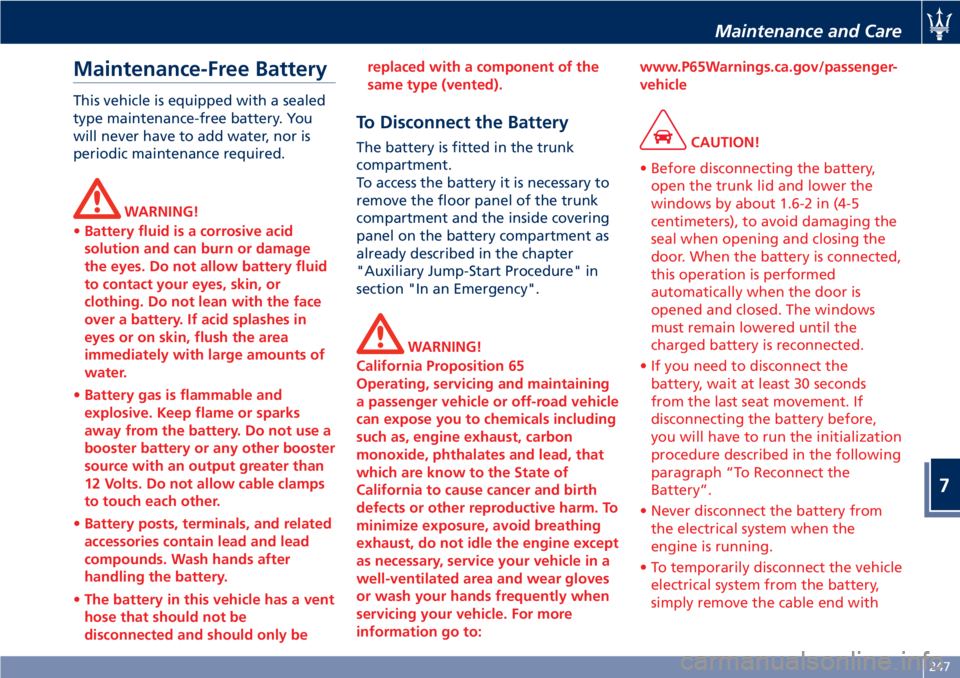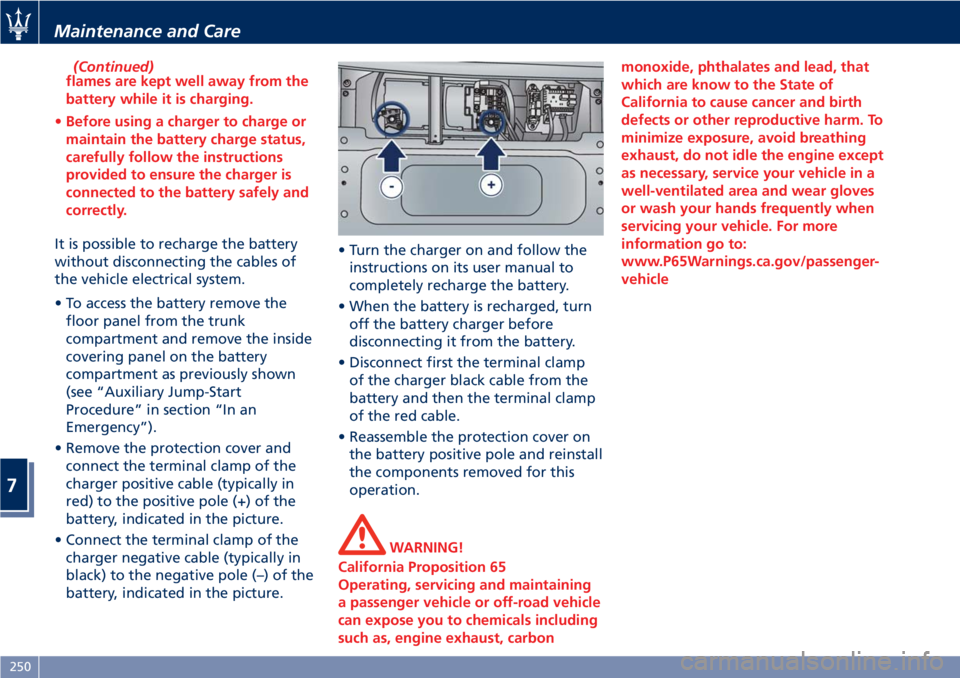2020 MASERATI GRANTURISMO CONVERTIBLE AUX
[x] Cancel search: AUXPage 229 of 296

NOTE:
After an emergency staring, you
should contact anAuthorized
Maserati Dealeras the emergency
starting procedure will have to be
carried out every time you want to
start the engine.Auxiliary Jump-Start
Procedure
If your vehicle has a discharged
battery it can be jump-started using a
set of jumper cables and a battery of
another vehicle or by using a portable
battery booster. It is necessary to have
proper jumper cables in order to
connect the booster battery to the
remote posts of the discharged
battery. Booster cables have usually
positive and negative terminal clamps
and are identified by a different
sheath color (red = positive, black =
negative). Maserati provides on
request jumper cables created for its
models and content in a practical case.
NOTE:
TheAuthorized Maserati Dealercan
provide you with information about
the “Maserati Jumper Cables Kit”,
available in the “Genuine Accessories”
range.
Jump-starting can be dangerous if
done improperly so please follow the
procedures in this section carefully.NOTE:
When using a portable battery
booster pack, follow the battery
manufacturer’s operating instructions
and precautions.
CAUTION!
• To jump start a vehicle do not use a
portable battery, a booster pack or
any other booster source with a
system voltage greater than 14 Volts
or damage to the battery, starter
motor, alternator or electrical system
of the vehicle with the discharged
battery may occur.
• Do not use a battery charger for
emergency starting under any
circumstances. You could damage
the electronic systems, particularly
the control units managing the
ignition and fuel supply functions.
• If the battery is completely
discharged when the windows are
fully raised, open the door with the
utmost care; do not close the door
again until it is possible to lower the
window.
In an Emergency
6
225
Page 251 of 296

Maintenance-Free Battery
This vehicle is equipped with a sealed
type maintenance-free battery. You
will never have to add water, nor is
periodic maintenance required.
WARNING!
•Battery fluid is a corrosive acid
solution and can burn or damage
the eyes. Do not allow battery fluid
to contact your eyes, skin, or
clothing. Do not lean with the face
over a battery. If acid splashes in
eyes or on skin, flush the area
immediately with large amounts of
water.
•Battery gas is flammable and
explosive. Keep flame or sparks
away from the battery. Do not use a
booster battery or any other booster
source with an output greater than
12 Volts. Do not allow cable clamps
to touch each other.
•Battery posts, terminals, and related
accessories contain lead and lead
compounds. Wash hands after
handling the battery.
•The battery in this vehicle has a vent
hose that should not be
disconnected and should only bereplaced with a component of the
same type (vented).
To Disconnect the Battery
The battery is fitted in the trunk
compartment.
To access the battery it is necessary to
remove the floor panel of the trunk
compartment and the inside covering
panel on the battery compartment as
already described in the chapter
"Auxiliary Jump-Start Procedure" in
section "In an Emergency".
WARNING!
California Proposition 65
Operating, servicing and maintaining
a passenger vehicle or off-road vehicle
can expose you to chemicals including
such as, engine exhaust, carbon
monoxide, phthalates and lead, that
which are know to the State of
California to cause cancer and birth
defects or other reproductive harm. To
minimize exposure, avoid breathing
exhaust, do not idle the engine except
as necessary, service your vehicle in a
well-ventilated area and wear gloves
or wash your hands frequently when
servicing your vehicle. For more
information go to:www.P65Warnings.ca.gov/passenger-
vehicle
CAUTION!
• Before disconnecting the battery,
open the trunk lid and lower the
windows by about 1.6-2 in (4-5
centimeters), to avoid damaging the
seal when opening and closing the
door. When the battery is connected,
this operation is performed
automatically when the door is
opened and closed. The windows
must remain lowered until the
charged battery is reconnected.
• If you need to disconnect the
battery, wait at least 30 seconds
from the last seat movement. If
disconnecting the battery before,
you will have to run the initialization
procedure described in the following
paragraph “To Reconnect the
Battery”.
• Never disconnect the battery from
the electrical system when the
engine is running.
• To temporarily disconnect the vehicle
electrical system from the battery,
simply remove the cable end with
Maintenance and Care
7
247
Page 254 of 296

(Continued)
flames are kept well away from the
battery while it is charging.
•Before using a charger to charge or
maintain the battery charge status,
carefully follow the instructions
provided to ensure the charger is
connected to the battery safely and
correctly.
It is possible to recharge the battery
without disconnecting the cables of
the vehicle electrical system.
• To access the battery remove the
floor panel from the trunk
compartment and remove the inside
covering panel on the battery
compartment as previously shown
(see “Auxiliary Jump-Start
Procedure” in section “In an
Emergency”).
• Remove the protection cover and
connect the terminal clamp of the
charger positive cable (typically in
red) to the positive pole (+) of the
battery, indicated in the picture.
• Connect the terminal clamp of the
charger negative cable (typically in
black) to the negative pole (–) of the
battery, indicated in the picture.• Turn the charger on and follow the
instructions on its user manual to
completely recharge the battery.
• When the battery is recharged, turn
off the battery charger before
disconnecting it from the battery.
• Disconnect first the terminal clamp
of the charger black cable from the
battery and then the terminal clamp
of the red cable.
• Reassemble the protection cover on
the battery positive pole and reinstall
the components removed for this
operation.
WARNING!
California Proposition 65
Operating, servicing and maintaining
a passenger vehicle or off-road vehicle
can expose you to chemicals including
such as, engine exhaust, carbonmonoxide, phthalates and lead, that
which are know to the State of
California to cause cancer and birth
defects or other reproductive harm. To
minimize exposure, avoid breathing
exhaust, do not idle the engine except
as necessary, service your vehicle in a
well-ventilated area and wear gloves
or wash your hands frequently when
servicing your vehicle. For more
information go to:
www.P65Warnings.ca.gov/passenger-
vehicle
Maintenance and Care
7
250
Page 290 of 296

Abbreviations.................7
ABS (Anti-lock Braking System) . . .179
A/C Air Filter Replacement.......263
Accessories
Aftermarket Parts and Accessories
Statement.................11
Accident, in the event of........213
A/C System Maintenance........262
Airbag.....................46
Air bag System Components.....46
Air bag Warning Light.........66
Passenger Air bag Labels.......18
Supplemental Restraint System
(SRS).....................46
Air Conditioning Controls.......151
Air Conditioning Distribution.....112
Alarm, Vehicle Security..........26
ALR (Automatic Locking Retractor) . .43
Assistance....................9
Assistance, if you need.........9
Audio Controls...............138
Steering Wheel Audio Controls . .138
Audio, Customer Setting........147
Audio System................140
Automatic Transmission........160
Automatic Transmission Range . .162
AUX, USB and SD Memory Card
Ports.....................132
Battery....................247
Access the Battery...........226
Jump Start Procedure........226
Maintenance - Free Battery. . . .247To Reconnect the Battery......248
Bluetooth, Customer settings.....147
Bodywork Maintenance and Care . .265
Protection from Atmospheric
Agents..................265
Useful Advice to Keep the
Bodywork in Good Condition . . .265
Brakes
Brake and Stability Control
System...................177
Brake Fluid Level Check.......242
Brake Overheating..........182
Parking Brake..............174
Parking Brake - Manual
Release..................220
Using the Brakes............181
Bulb Replacement............257
Cargo Area.................107
Child Restraint Systems
Children too large for Booster
Seats.....................56
Infants and Child Restraints.....55
Lower Anchors and Tether for
Children (LATCH)............57
Older Children and Child
Restraints.................55
Tips on getting the most out of
your child restraint...........56
Clock, analog................144
Comfort Pack Front Seats........76
Driver Memory Seat..........77
Front Heated Seats...........76Console
Central Console Components....73
Front Dome Console
Components...............71
Cruise Control...............185
Cupholders
Front Seats Cupholders.......103
Rear Seats Cupholders........104
Dashboard Components.........70
Data, Technical..............279
Defroster...................66
Doors Components.............72
Drive Mode, Controls..........169
Driving Conditions
Before the Trip.............204
Driving at Night............204
Driving in Fog..............205
Driving in the Mountains......205
Driving in the Rain..........204
Driving on Snow or Ice........206
Driving through Flooded
Sections..................206
Safe Driving...............204
DRL (Daytime Running Light)......83
Easy Entry/Exit function.........79
EDR (Event Data Recorder).......52
Emergency
Emergency Fuel Filler Door
Release..................203
Hazard Warning Flasher.......88
In the Event of an Accident. . . .213
Index
9
286
Page 292 of 296

Inside Rearview Mirror........81
Mirrors Positioning...........80
Outside Mirrors.............80
MTC+ “Controls” Screen........141
MTC+ Settings - Customer
Programmable Features.......141
MTC+ System (Maserati Touch
Control Plus), Controls........138
Onboard Computer (Trip).......167
Onboard Diagnostics System.....183
ORC
(Occupant Restraint Controller) . . .50
Park Assist...................60
Parking....................176
Parking Brake...............174
Emergency Release of Parking
Brake...................220
Parking (Camera)..............63
Part Service..................11
Pets, transporting.............59
Phone/Bluetooth
Phone and Voice Controls on
Steering Wheel.............155
Phone/Bluetooth, Customer
settings..................147
Phone Mode..............156
Voice Commands...........156
Pollution Control Devices.......207
Power Outlets...............102
Refillings...................276Refueling..................202
Reporting Safety Defects.........10
Restraint System
Child Restraint Systems........54
Occupant Restraint System......38
Roadside Assistance Program......15
Safety
Child Restraint Systems........54
Occupant Restraint System......38
Safety Tips.................65
Supplemental Restraint System -
Air bags..................46
Scheduled Maintenance Service . . .232
Scheduled Service Plan.........234
SD Memory Card, USB and AUX
Ports.....................132
Seat Belt
Load Limiting Devices.........44
Loking Retractor (ALR) Mode....43
Rear Passenger Seat Belts.......42
Seat Belt Reminder Light
.....
.121
Seat Belt Reminder System (SBR) . .45
Seat Belts and Pregnant Women . .45
Seat Belts Pretensioners........44
Three-Point Seat Belts.........40
Three-Point Seat Belts Untwisting
Procedure.................42
Seats, Front..................74
Front Seats Cupholders.......103
Power Lumbar..............75
Seat Adjustment.............74
Seatback Tilt...............75Seats, Rear..................78
Rear Armrest...............79
Rear Head Restraints..........78
Rear Seats Cupholders........104
Service and Warranty............8
Siri Smart Personal Assistant.....156
Skyhook Suspension...........114
Smoking Kit.................106
Snow Chains................193
SRS (Supplemental Restraint System) -
Air Bags...................46
Start the Engine
Engine Start Failure..........159
Normal Starting of the Engine . .158
Steering Wheel Adjustment.......79
Phone and Voice Controls on
Steering Wheel.............155
Stored, Vehicle...............269
Stuck Vehicle, Freeing..........223
Symbols....................12
Tank, Fuel Refill..............202
Technical Data...............279
Telltales
Telltales on Speedometer......119
Telltales on Tachometer.......121
TFT Display: Warning/Indicator
Lights...................124
TFT Display
Controls..................124
Menus and Settings..........124
Screen Pages..............125
Tire Repair Kit...............214
Index
9
288
Page 293 of 296

Tires
Department of Transportation
Uniform Tire Quality Grades. . . .189
General Information.........187
Inflation Pressure...........284
Punctured Tire.............214
Replacement Tires..........192
Snow Chains..............193
Tire Pressure..............190
Tire Pressure Checkup........191
Tire Repair Kit.............214
Tire Safety Information.......187
Tires Durability.............192
TPMS - Tire Pressure Monitoring
System..................194
Tread Wear Indicators........191
Winter Tires...............193
ToolKit ...................212
Towing the Vehicle...........228
TPMS System................194
Transmission, Automatic
Automatic Transmission Lever . .160
Malfunction and Overheating
Conditions................166
Transmission Manual Release of
P (Park) Position............221
Trip - Onboard Computer.......167
Trunk
Trunk Safety...............37
Trunk Compartment Lid.........35Trunk Lid
Trunk Lid Emergency Release from
inside the Trunk.............37
Updating....................7
USB, AUX and SD Memory Card
Ports....................132
Vehicle Identification Data
Homologation Labels.........18
Vehicle Identification Number
(VIN)....................17
Warning and Information Labels .18
Voice Commands.............156
Warning Icons.................6
Warning/Indicator Lights on TFT
Display...................126
Warnings when Driving.........14
Warranty and Service............8
Warranty Information..........10
Wheels
Tires Maintenance..........263
Wheels Rims Maintenance....
.265
Windows
Auto Down/Auto Up Feature....34
Reset Auto-Up/Down.........35
Windshield Wipers and Washers . . .89
Adding Washer, Headlight Washer
Fluid....................243
Rain Sensing Wipers..........90
Windshield and Headlight
Washers..................91Windshield Wipers...........89
Wiper Maintenance and Blades
Replacement..............245
Index
9
289